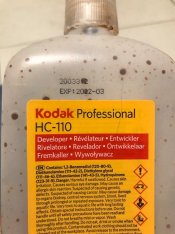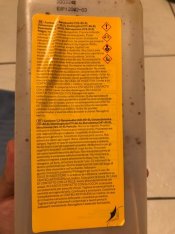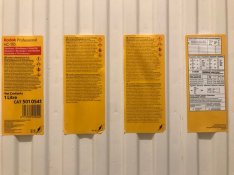I am attaching composition information for the old HC-110, taken from an MSDS dated 2016, and the new HC-110, taken from an MSDS dated 2019: First the old and then the new.
There are several things we can glean from these. The first is that, regardless of whether they are functionally similar, they are very different formulations. I will return to that point later.
Note the hydroquinone percentages. They are given as ranges due to trade secret issues. However, note that one MSDS lists it as 5-10% and the other lists it as 10-20%. Those two ranges intersect at 10%, so it's a pretty good bet that it is 10% hydroquinone for both formulations. That's not a sure thing however.
The second thing to note is that the sulfite or sulfite equivalent concentrations are very different. The old formulation lists 15-20% sulfur dioxide. (Note that sulfur dioxide becomes sulfurous acid when the developer is mixed with water, which in turn becomes sulfite in basic solution.) The new formula lists potassium sulfite as 10-20%. (I'm ignoring the "<" sign because it is probably meaningless in this situation.) Considering the difference in molecular weight of SO2 and K2SO3, the equivalent sulfite concentration in the old formula is at least 1.84 times higher in the old formula compared to the new formula, and the factor could be as much as 4.94X.
Next, note that, as pointed out by Alan Johnson, the fact that the new formulation contains a high amount of potassium sulfite implies that the formula almost certainly has a high water composition. Otherwise the K2SO3 wouldn't dissolve in the concentrate, unless there is something that can sequester the ions in such a way as to make them soluble in non-aqueous solvents. It's possible that the diethylene glycol might serve this purpose, at least for potassium ions, due to the structural similarity of diethylene glycol to crown ethers, but I doubt if diethylene glycol is a strong enough complexing agent with potassium to make this possible. In any case, that still leaves the problem of solubilizing the doubly charged sulfite ions into a non-aqueous solution. The fact that non-aqueous liquids are only a small part of the new formulation also suggests that there is a lot of water, although non-toxic liquids like propylene glycol might be present and not listed(?) in the msds, so this it is not definitively proven that the formula contains a lot of water.
Note that 1,2 Benzenediol is listed in both sheets. That's catechol, which is a developer. However, my guess is that it is not included for any functional reason, but is probably a side product in the synthesis of hydroquinone, and it's not worth it to try to purify it out because it doesn't harm the function of the developer.
Diethylenetriaminepetnaacetic acid is listed in the old formula. That compound is usually used to complex metal ions in most applications. I can't guess why it's in the old formula (unless it's to help condition dilution-water that contains a lot of iron or some-such), or why it's not in the new formula.
The old formula contains potassium bromide (although I don't know how they manage to keep that in solution), but the new formula does not. Since potassium bromide is a restrainer, it makes you wonder what restrainer they are using in the new formula and also whether the new formula is a low-fog developer like the old formula.
Anyway, the formulations are quite different, and even though they are said to work similarly to each other under normal conditions does not mean they are likely to work similarly under more extreme conditions.
And of course there is that nagging question of shelf life. If I had to bet the farm my guess would be that the shelf life of the new formula is probably only a fraction of that of the old formula, and if so it is a very significant difference for some of us.












 .
.





